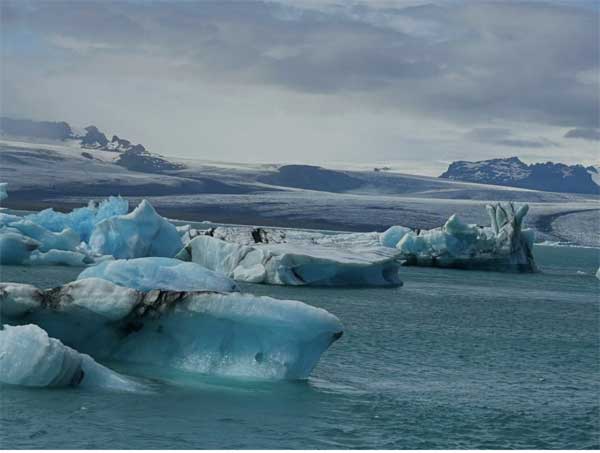Record-breaking heat wave accelerates Icelandic glacier melt

[Jökulsárlón Glacier Lagoon in Iceland. Photo Credit to Olivia Bak]
In May, local residents in Iceland observed record-breaking heat arriving weeks early as massive crystal-blue icebergs, newly formed from melting glaciers, filled the vibrant turquoise waters of Jökulsárlón, one of Iceland’s most iconic glacial lagoons.
This spring was Iceland’s hottest on record, with temperatures climbing above 20°C for 10 consecutive days at several weather stations throughout May across the country.
During this period, local residents observed an unusually high number of floating icebergs, increased surface runoff, and widening crevasses as the glaciers continued to melt.
While tourists saw the striking beauty of floating icebergs, many local residents viewed them as warning signs of rising temperatures.
According to the Icelandic Meteorological Office, this heatwave, with temperatures well above the seasonal average, is the most intense heat event ever recorded in Iceland and established a new national May temperature record of 26.6°C, surpassing levels not seen since a comparable heatwave in 1987.
The data reveals a troubling trend.
Over the past 25 years, Icelandic glaciers have lost about 10% of their total area, with their average mass loss per unit area ranking among the highest of any major glacier-covered region in the world.
Although Icelandic glaciers have been shrinking for years, experts now attribute the recent acceleration in melting to climate change.
A recent analysis by World Weather Attribution found that climate change has made extreme heat events in Iceland more intense and frequent, a trend likely to persist into the future.
Even more alarming, previous simulation calculations by the Icelandic Meteorological Office suggest that Iceland could be virtually glacier-free within the next 100 to 200 years if temperatures continue to rise.
The potential disappearance of all Icelandic glaciers in coming decades raises concerns about the long-term sustainability of glacier tourism in the country.
Iceland's economy has largely been built around its glaciers, which attract over 2 million tourists annually and support various industries such as hospitality, guided tours and excursions, transportation, and local crafts.
Especially in the southeast area, an extensive network of glacier lagoon boat tours, ice cave adventures, ice climbing, glacier hiking, and snowmobiling, as well as restaurants and hotels, operates around glacier tourism.
As glaciers retreat and meltwater increases, new lagoons are formed, much like Jökulsárlón Glacier Lagoon.
In the future, even more glacier lakes may form and existing lagoons may expand as melting ice fills natural depressions and basins in the landscape.
As these glacier lakes grow in number and size, the risk of glacial lake outburst floods increases, posing a threat to local communities and tourism activities.
Iceland’s government is committed to promoting sustainability in tourism and has developed a comprehensive action plan to address the challenges of rapidly shrinking glaciers.
The action plan outlines national strategies focused on protecting fragile glaciers as well as strengthening local communities’ abilities to adapt to ongoing environmental changes and develop new sustainable tourism models.
There is widespread consensus among Icelandic communities that the future of glacier tourism on which the nation depends requires not only comprehensive national strategies but also a collective commitment to preservation and adaptation.
Many Icelandic residents have actively responded to melting glaciers impacting tourism by promoting sustainable tourist practices, diversifying tourism attractions, advocating for stronger protections for fragile glaciers, and collaborating with scientists to monitor glacier conditions.
With collective and decisive action, Iceland aims to the success of these efforts and preserve its natural heritage and tourism opportunities for future generations.

- Olivia Bak / Grade 9
- Woodson High School

![THE HERALD STUDENT REPORTERS [US]](/assets/images/logo_student_us.png)
![THE HERALD STUDENT REPORTERS [Canada]](/assets/images/logo_student_ca.png)
